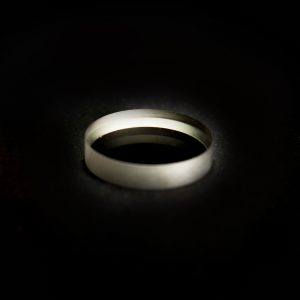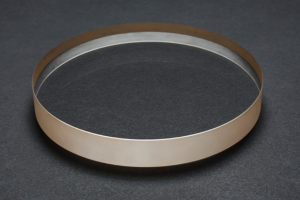High borosilicate glass (also known as hard glass) is made by using the conductivity of glass under high temperature to realize glass melting through heating inside the glass and processed by advanced production technology. The linear thermal expansion coefficient is (3.3 ± 0.1) × 10-6 / K, also known as “borosilicate glass 3.3”. It is a special glass material with low expansion rate, high temperature resistance, high strength, high hardness, high light transmittance and high chemical stability. Because of its excellent performance, it is widely used in solar energy, chemical industry, pharmaceutical packaging, electric light source, craft jewelry and other industries. Its good performance has been widely recognized by all sectors of the world, especially in the field of solar energy, which has been widely promoted in developed countries such as Germany and the United States.
Borosilicate glass is made by adding sodium silicate sand, soda water and ground lime of the glaze made of boron traditional glass. Because borosilicate glass melts at a higher temperature than ordinary silicate glass, some new technologies are needed to make industrial production. Borrowing from the welding trade, combined with the need for new natural gas to burn oxygen.
The fire resistance and physical strength of borosilicate glass make it an ideal choice in the laboratory. It is used to manufacture laboratory equipment such as beakers and test tubes. In addition, the minimum exposure of borosilicate glass bending allows the volume of borosilicate heat-resistant container to provide accurate measurement for a period of time.
In the middle of the 20th century, borosilicate glass tube coolant was used (usually distilled water) through high-power vacuum tube based electronic equipment, such as commercial broadcast transmitters.
Glass cookers are another common use. A borosilicate glass pie plate is almost an American Standard plate. Borosilicate glass measuring cup, which is marked to indicate graduation measurement, is also widely used in American kitchens.
Aquarium heaters are sometimes made of borosilicate glass. Because of its high heat resistance, it can tolerate the temperature difference between water and Ni Cr alloy heating elements.
Many high-quality flashlights use borosilicate glass for lenses. This allows a higher proportion of light transmittance through the lens than plastic and low-quality glass.
Professional lighters and pipes are made of borosilicate glass. The high heat resistance allows the pipes to tolerate longer service life, and these pipes are also more durable.
Most premanufactured Glass Guitar slides also make borosilicate glass.
New wire drawing technology enables the application of glass ball and other contemporary art. The modern glass art movement promoted the rapid development of borosilicate glass in the Northstar color palette in the 1980s and 1990s, mainly providing a broad economic growth of borosilicate glass suppliers. Borosilicate is commonly used in the form of brushed glass blowing and artists have created a range of products from jewelry and kitchenware to sculpture and art 70955.
Borosilicate glass is sometimes used for high-quality beverage glassware. Borosilicate glass lends increased durability to kitchenware and glassware with microwave oven and dishwasher compatibility.
Most astronomical telescope mirror assemblies are made of glass because it has a low coefficient of thermal expansion with borosilicate glass. This makes it possible for a very accurate optical surface to change very little with temperature, and matches the glass mirror assembly to “track” changes in temperature and retain the characteristics of the optical system. The most common optical glass lens manufacturing tool uses Schott shoal – 7 (or equivalent from other manufacturers), a very fine borosilicate glass crown. It is also designated as 517642 glass with a refractive index of 1.517 and Abbe number of 64.2. Other more expensive borosilicate glasses, such as Schott B270 or equivalent, can be used to manufacture “crown glass” spectacle lenses. The cost of ordinary low borosilicate glass, which is used to manufacture Kitchenware and even reflective telescope mirrors, cannot be used to cope with the high-quality lenses of lower grades of this glass type due to stripes and inclusions.
Borosilicate is also a kind of material to choose vacuum tube solar energy heat utilization technology, because of its high strength and heat resistance.
Borosilicate glass is also famous for the MEMS of micro mechanical devices. It is developed and applied in the bonded etching of silicon borosilicate glass in the semiconductor industry as part of the etching wafer stack.
The insulating tiles on the space shuttle are coated with borosilicate glass. Lighting manufacturers use their refracted borosilicate glass.
Its main performance indexes meet the international ISO standard, which is the same as the 7740 material of Corning company in the United States and the 50 material of Schott company in Germany. Compared with common glass, it has no toxic and side effects. Its mechanical properties, thermal stability, water resistance, alkali resistance, acid resistance and other properties are greatly improved. It can be widely used in various fields such as chemical industry, aerospace, military, family, hospital and so on. It can be made into lamps, tableware, standard plates, telescope pieces, observation holes of washing machines, microwave oven plates, solar water heaters and other products, which has good promotion value and social benefits, The appearance of this kind of glass in China is another new revolution in the basic material industry.
Solar water heater, the main material of vacuum collector tube, mainly uses its good light transmittance, good mechanical properties and good impact resistance. The low iron glass used by some manufacturers lacks the above properties and is different from high borosilicate in weight and appearance. (the color is dark and light. It is generally used by small manufacturers)
Borosilicate glass has a very low coefficient of thermal expansion, about one-third of that of ordinary glass. This will reduce the stress caused by temperature gradient stress
Therefore, it has stronger fracture resistance. Because its shape deviation is very small, it has become an essential material in telescopes and mirrors. It can also be used to treat high-level radioactive nuclear waste. Borosilicate glass begins to soften about 821 ℃ (1510 ℉). At this temperature, 7740 type high viscosity borosilicate is 107.6 weight.
Borosilicate glass is less dense than ordinary glass.
Although more and more resistant to thermal shock than other types of glass, borosilicate glass can still be broken due to rapid or uneven temperature changes. When broken, borosilicate glass cracks tend to be large rather than crushed (it will be unit rather than split). Optically, borosilicate glass has low dispersion (about 65 Abbe crown glasses) and relatively low refractive index (the whole visible light range is 1.51-1.54).
G3 3. The linear expansion coefficient of high borosilicate glass is 3.3 ± 0.1 × 10-6 / K is a kind of glass with sodium oxide (Na2O), boron oxide (B2O3) and silicon dioxide (SiO2) as the basic components. The content of borosilicate in the glass is high, which is boron: 12.5 ~ 13.5%, silicon: 78 ~ 80%, so this kind of glass is called high borosilicate glass. It belongs to Pyrex glass in borosilicate glass. Acid, alkali and water resistance, excellent corrosion resistance, good thermal stability, chemical stability and electrical performance, so it has the characteristics of chemical corrosion resistance, thermal shock resistance, good mechanical performance, high temperature resistance and so on.
The amount of tin infiltrated on the lower surface of float high borosilicate glass, the valence state of tin infiltrated and the depth of tin infiltrated have a great impact on the quality of float glass and glass deep processing. The amount of tin infiltrated on glass seriously affects the deep processing of glass.
Compared with high borosilicate glass and sodium calcium silicate glass, if the temperature at the front end of the tin bath is increased by about 300 ℃, the tin vapor pressure is increased by 142 times. In this way, when producing high borosilicate glass by float method, the glass liquid is like being in the steam bath of tin. At the same time, due to the increase of the temperature of producing high borosilicate glass by several Baidu, the activity of tin ions is greatly enhanced, the ability of tin ions to penetrate into the surface of glass pole is greatly enhanced, the possibility of tin infiltration is greatly increased, and tin infiltration has a greater impact on the change of glass surface properties, which is one of the problems to be solved by float glass process.



